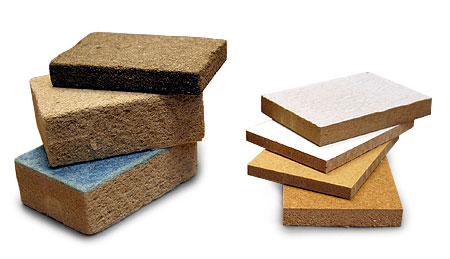Fiberboards are made by grinding moist wood fibers in hot temperature. The fibers are compressed into a board by using a hot press. Porous fiber boards are done differently. They are compressed into a board by drying the board without using a hot press. The materials used in Finland are mainly sawdust and other small wood particles.
Manufacturing methods are divided into two groups: wet method and dry method.

During the wet method the fibers are in water. The boards are manufactured the same way as paper; the water-fiber mix is put on top of wire netting. A thick board compressed into a thin fiber board by using a hot press. A lot of water escapes the board during this process. In order to remove water from the board a small holed wire netting is needed at the bottom of the board. This netting leaves a mark on the backside of the board. The sawdust has an adhesive that works well for gluing the particles together for forming the board. Glue is sometimes added to the mix. A lot of water is needed to make the boards. Nowadays however the water can be recycled efficiently during this process.
Boards made with a wet method in Finland are for example
- Hardboard (EN 13986:n),
- Porous fiber board for dry conditions (HB ja SB)
- Fiber boards for wet conditions (SB.H ja HB.H).
The usage of the dry method has increased dramatically after the production of MDF’s (Medium Density Fibreboard) has increased. The fibers are dried and glued together. They are then hot pressed into a board the same way as a chip board is done. The adhesives of the sawdust can’t be used as an advantage when making these boards. The process of making thick boards is simpler and both sides of the board are flat and smooth.
LDF’s (Low Density) and HDF’s (High Density Fibreboard) are done with the same methods. There are no factorys in Finland that use the dry method.
Fiberboard types
- Hardboard
- Painted hardboard
- Oil tempered hardboard
- Wood grain textured board
- Perforated board
Wet method boards
- Porous fiber boards, the thickness of the board is less than 400 kg per m3
- Wind shield boards
- Cladding boards
- Semi-hardboard, the thickness of the board is 400 – 900 kg per m3
- Hardboard, the thickness of the board is 900 kg per m3
Dry method boards
- MDF, thickness is usually 600 – 1000 kg per m3
- Through dye boards
- Articulated boards
- Fire-preventing boards
- LDF and HDF (Low Density ja High Density Fibreboard)